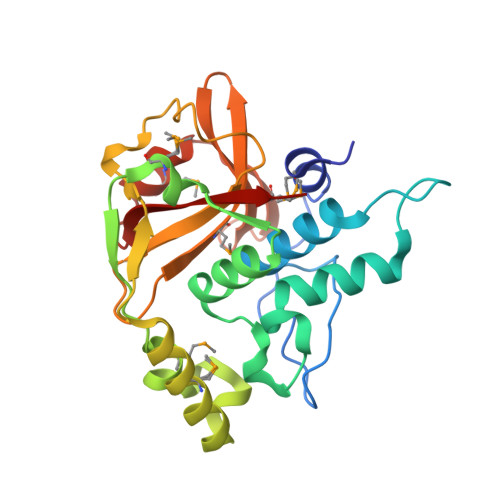Structure-guided functional characterization of DUF1460 reveals a highly specific NlpC/P60 amidase family.
Xu, Q., Mengin-Lecreulx, D., Patin, D., Grant, J.C., Chiu, H.J., Jaroszewski, L., Knuth, M.W., Godzik, A., Lesley, S.A., Elsliger, M.A., Deacon, A.M., Wilson, I.A.(2014) Structure 22: 1799-1809
- PubMed: 25465128
- DOI: https://doi.org/10.1016/j.str.2014.09.018
- Primary Citation of Related Structures:
4H4J, 4Q5K, 4Q68 - PubMed Abstract:
GlcNAc-1,6-anhydro-MurNAc-tetrapeptide is a major peptidoglycan degradation intermediate and a cytotoxin. It is generated by lytic transglycosylases and further degraded and recycled by various enzymes. We have identified and characterized a highly specific N-acetylmuramoyl-L-alanine amidase (AmiA) from Bacteroides uniformis, a member of the DUF1460 protein family, that hydrolyzes GlcNAc-1,6-anhydro-MurNAc-peptide into disaccharide and stem peptide. The high-resolution apo structure at 1.15 Å resolution shows that AmiA is related to NlpC/P60 γ-D-Glu-meso-diaminopimelic acid amidases and shares a common catalytic core and cysteine peptidase-like active site. AmiA has evolved structural adaptations that reconfigure the substrate recognition site. The preferred substrates for AmiA were predicted in silico based on structural and bioinformatics data, and subsequently were characterized experimentally. Further crystal structures of AmiA in complexes with GlcNAc-1,6-anhydro-MurNAc and GlcNAc have enabled us to elucidate substrate recognition and specificity. DUF1460 is highly conserved in structure and defines another amidase family.
- Joint Center for Structural Genomics (JCSG); Stanford Synchrotron Radiation Lightsource, SLAC National Accelerator Laboratory, Menlo Park, CA 94025, USA.
Organizational Affiliation:



















